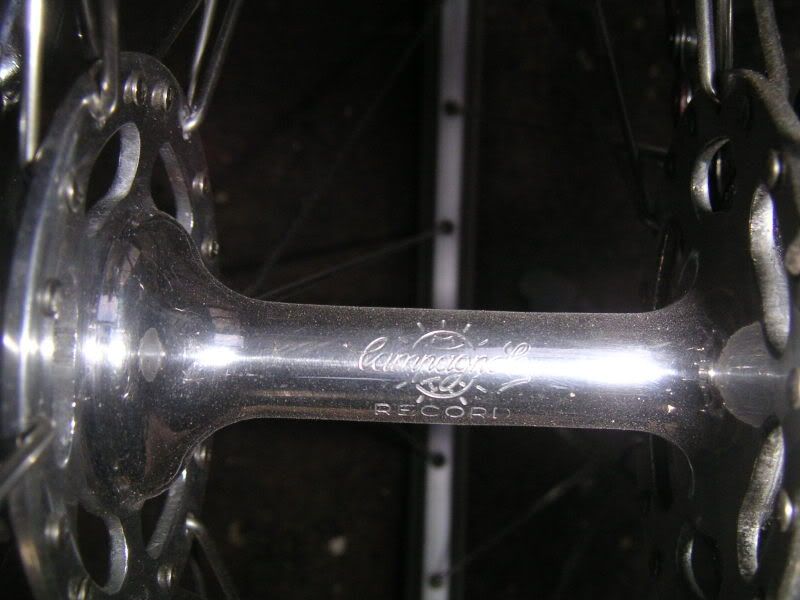After lacing a few wheels with 3 cross patterns I wanted to try something a bit different. After some browsing I decided to try this crow's foot pattern. I read up on it here. The instructions are pretty comprehensive but I thought some pictures would be useful.
So here goes. The spoke lengths are obtained by looking for zero crosses and either two or three cross lengths. (More on this later). If you input your hub and rim dimensions into your favorite spoke length calc you can state zero crosses for one side and two or three crosses for the other. When you know what length spokes you need you'll want to lay your hands on 12 of the radial length spokes and 24 of the crossed length. I found lengths I needed in my stock of spokes, it just so happened they were different colours. It certainly makes it easier to see which are radial and which cross.
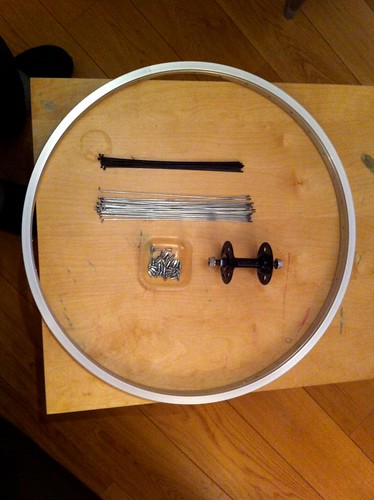
On the first step. Lace in the radial (shorter) spokes through the hub on the side furthest from you. Leave two flange holes between each spoke. Flip the hub over and choose a hole in the rim that is off set towards you. You can start off on the left or right on the valve hole (which ever is the slightly closer). Work your way round the rim, you should have five spoke holes in the rim between each of the six spokes.
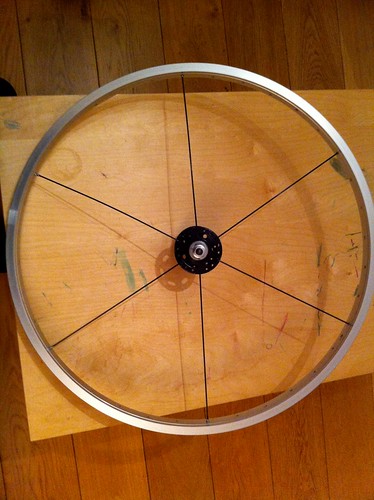
With the hub the same way up you're going to thread the remaining 6 radial spokes through the oposite flange. Now comes your first decision. You can either have the radial spokes next to each other or have them at 90 degrees. I chose next to each other for looks, but I've no idea if structurally it's better one way or the other. If you choose to have each radial spoke running almost parrallel have a look up at where you placed the first spoke. With the valve hole sitting at 12 o'clock the first spoke you laced will be to the left or right of the valve hole. Looking down at the holes on the bottom flange you'll notice they're slightly off set. You want to lace the first spoke of the bottom flange through the hole slightly off to the same side as the hole on the other side of the valve hole. If you go for 90 degrees then go for the hole in the bottom flange 90 degrees to the two spokes coming of the flange closest to you. Again leave two holes on the flange between the radial spokes. Once you're done flip the hub and rim over and lace in the spokes. The parallel memthod will be straight forward, you'll be left with four holes between each set of two spokes. The 90 degree way you'll be left with two holes on the rim between each spoke coming from either side of the hub.
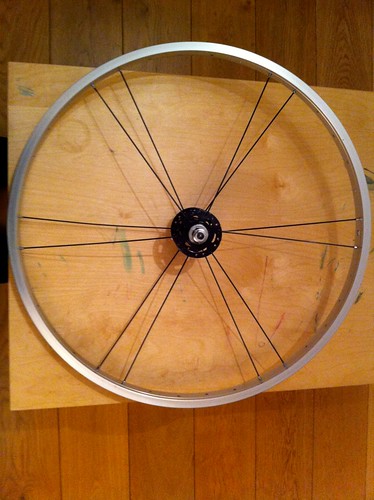
So now to the crossing spokes. This is where if you went for two or three cross length spokes will come in. In two cross situation, the crossing spokes will go over the radial spoke closest to it. In the three cross situation the cross will happen with the radial spoke furthest from it. Start by threading six spokes to the left of the radial spokes. In the case of either pattern, you'll go one rim hole to the other side of the radial spoke you are crossing. Lace all six spokes across the radial spokes. Now you want to do the same for the other flange. Do this by flipping the hub and rim and threading six more spokes to the left of the radial spokes. By doing it this way you'll end up with a wheel that's better balanced as each side is going in the opposite direction.
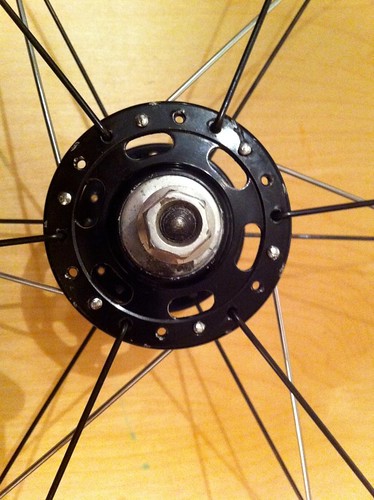
Before flipping the hub back, thread spokes through the opposite flange. Flip the hub over then cross the radial spoke at the same point and hopefully you'll end up lining up with a hole on the same side of the rim as the flange.

Once you've done one side. It should look something like this. This has only one side laced with crossing spokes to hopefully make it clearer.
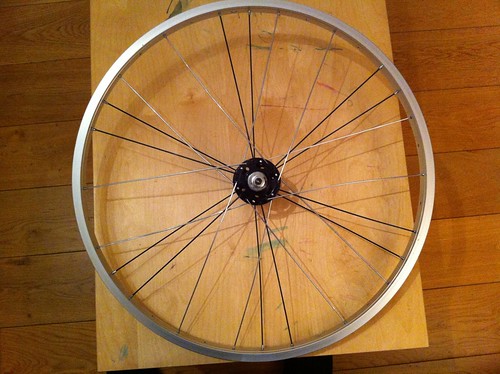
Again thread the six spokes through the opposite flange then flip the hub over. Once both sides are done it'll look like the picture below.

A few notes at this point seem appropriate.
This pattern will only work on hubs and rims with a hole count divisable by three. i.e. 36 and 48 For alternatives see other patterns on the Spokenwheel website I also recommend reading through the excelent topic on lacing wheels here http://ratrodbikes.com/forum/viewtopic.php?f=3&t=2887&p=27578#p30168
When lacing up this pattern only do up the nipples a couple of turns to hold it in place. Then take up the slack on those nipples as you are truing the wheel.
For the two cross pattern all the spokes should lie on the outside of the flanges. For the three cross pattern, you can do as I have done here and put half under the radial spoke and the other half over. This means you're not crossing the other crossing spoke on the flange. The spoke crossing under will be slacker than the crossing spoke going over the radial spoke and might need filed down. I managed to re-lace this hub with all the spokes lying on the outside of the flange. There was a lot of un-lacing and re-lacing until it felt right. But this way with all of spokes lying on the outside, the wheel felt much stiffer. I'll post another pic when I can.
Cheers Jonnie
So here goes. The spoke lengths are obtained by looking for zero crosses and either two or three cross lengths. (More on this later). If you input your hub and rim dimensions into your favorite spoke length calc you can state zero crosses for one side and two or three crosses for the other. When you know what length spokes you need you'll want to lay your hands on 12 of the radial length spokes and 24 of the crossed length. I found lengths I needed in my stock of spokes, it just so happened they were different colours. It certainly makes it easier to see which are radial and which cross.

On the first step. Lace in the radial (shorter) spokes through the hub on the side furthest from you. Leave two flange holes between each spoke. Flip the hub over and choose a hole in the rim that is off set towards you. You can start off on the left or right on the valve hole (which ever is the slightly closer). Work your way round the rim, you should have five spoke holes in the rim between each of the six spokes.

With the hub the same way up you're going to thread the remaining 6 radial spokes through the oposite flange. Now comes your first decision. You can either have the radial spokes next to each other or have them at 90 degrees. I chose next to each other for looks, but I've no idea if structurally it's better one way or the other. If you choose to have each radial spoke running almost parrallel have a look up at where you placed the first spoke. With the valve hole sitting at 12 o'clock the first spoke you laced will be to the left or right of the valve hole. Looking down at the holes on the bottom flange you'll notice they're slightly off set. You want to lace the first spoke of the bottom flange through the hole slightly off to the same side as the hole on the other side of the valve hole. If you go for 90 degrees then go for the hole in the bottom flange 90 degrees to the two spokes coming of the flange closest to you. Again leave two holes on the flange between the radial spokes. Once you're done flip the hub and rim over and lace in the spokes. The parallel memthod will be straight forward, you'll be left with four holes between each set of two spokes. The 90 degree way you'll be left with two holes on the rim between each spoke coming from either side of the hub.

So now to the crossing spokes. This is where if you went for two or three cross length spokes will come in. In two cross situation, the crossing spokes will go over the radial spoke closest to it. In the three cross situation the cross will happen with the radial spoke furthest from it. Start by threading six spokes to the left of the radial spokes. In the case of either pattern, you'll go one rim hole to the other side of the radial spoke you are crossing. Lace all six spokes across the radial spokes. Now you want to do the same for the other flange. Do this by flipping the hub and rim and threading six more spokes to the left of the radial spokes. By doing it this way you'll end up with a wheel that's better balanced as each side is going in the opposite direction.

Before flipping the hub back, thread spokes through the opposite flange. Flip the hub over then cross the radial spoke at the same point and hopefully you'll end up lining up with a hole on the same side of the rim as the flange.

Once you've done one side. It should look something like this. This has only one side laced with crossing spokes to hopefully make it clearer.

Again thread the six spokes through the opposite flange then flip the hub over. Once both sides are done it'll look like the picture below.

A few notes at this point seem appropriate.
This pattern will only work on hubs and rims with a hole count divisable by three. i.e. 36 and 48 For alternatives see other patterns on the Spokenwheel website I also recommend reading through the excelent topic on lacing wheels here http://ratrodbikes.com/forum/viewtopic.php?f=3&t=2887&p=27578#p30168
When lacing up this pattern only do up the nipples a couple of turns to hold it in place. Then take up the slack on those nipples as you are truing the wheel.
For the two cross pattern all the spokes should lie on the outside of the flanges. For the three cross pattern, you can do as I have done here and put half under the radial spoke and the other half over. This means you're not crossing the other crossing spoke on the flange. The spoke crossing under will be slacker than the crossing spoke going over the radial spoke and might need filed down. I managed to re-lace this hub with all the spokes lying on the outside of the flange. There was a lot of un-lacing and re-lacing until it felt right. But this way with all of spokes lying on the outside, the wheel felt much stiffer. I'll post another pic when I can.
Cheers Jonnie





